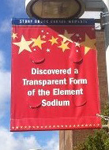Research
 My research, interdisciplinary by nature, marries theoretical crystallography, condensed matter physics, theoretical chemistry, materials science, computational mathematics, and Earth sciences. I develop and apply novel computational methods, with the aim of predicting and understanding the behavior of materials (fundamentally interesting or technologically useful materials, planet-forming or synthetic materials, etc.). The major goal of my research is to enable computational materials discovery. With the help of theory and computation, I aim to understand the factors governing the structure and properties of solids, their structural and electronic transitions - especially under pressure, where conventional rules and models often break down.
My research, interdisciplinary by nature, marries theoretical crystallography, condensed matter physics, theoretical chemistry, materials science, computational mathematics, and Earth sciences. I develop and apply novel computational methods, with the aim of predicting and understanding the behavior of materials (fundamentally interesting or technologically useful materials, planet-forming or synthetic materials, etc.). The major goal of my research is to enable computational materials discovery. With the help of theory and computation, I aim to understand the factors governing the structure and properties of solids, their structural and electronic transitions - especially under pressure, where conventional rules and models often break down.
Among the highlights of this research are:
- USPEX: novel method for crystal structure prediction (EPSL 2006, J.Chem.Phys. 2006, Comp.Phys.Comm. 2006, Acc. Chem. Res. 2011).
- Evolutionary metadynamics: another powerful method for predicting crystals structures, also capable of predicting phase transformation mechanisms (CrystEngComm 2012).
- Development of a method for quantifying and visualizing energy landscapes (J.Chem.Phys. 2009).
- Variable-cell nudged elastic band method for predicting mechanisms of phase transitions (Comp. Phys. Comm. 2013).
- Development of a hybrid global optimization method for searching for materials with target physical properties, which offers a novel way for materials discovery on the computer. (PRB 2011)
- Joint theoretical/experimental discovery of MgSiO3 post-perovskite, the main mineral of the Earth's D'' layer (Nature 2004). This discovery has been confirmed by a number of independent studies.
- First theoretical studies of the rheology of MgSiO3 perovskite and post-perovskite (Nature 2005) based on first-principles metadynamics, and a new interpretation of the seismic anisotropy of the Earth's D'' layer. Prediction of a polytypic series of structures between perovskite and post-perovskite, possible new mantle minerals, experimentally confirmed by O.Tschauner in 2008.
- Mineral physics interpretation of seismic tomography in terms of temperature distribution in the Earth's mantle (Nature 2001). Thermal model of the Earth's mantle (EMU Lecture Notes 2002).
- Ab initio phase diagrams of Earth-forming minerals (Nature, PNAS, PRL, Phys.Rev.B, J.Chem.Phys., 2003-2006). Prediction and discovery of novel high-pressure mineral phases of CaCO3 (EPSL 2006), MgCO3 and CO2 (EPSL 2008), Fe2C (Uspekhi-Physics 2012).
- Advanced pressure calibration methods for experiments in diamond anvil cells, and novel P-T pressure scales (DAN 2003, 2006; PRB 2007).
- Discovery of novel high-pressure structures of the elements - partially ionic phase of boron (Nature, January 2009) and transparent insulating phase of sodium (Nature, March 2009). Prediction and elucidation of pressure-induced structural transformation in methane (J.Chem.Phys. 2010), silane (PRL 2009), germane (PRL 2008), stannane (PNAS 2010), carbon (PRL 2009), nitrogen (PRL 2009), calcium (PNAS 2010), novel lithium hydrides (PNAS 2009), phases of graphane (PNAS 2011), xenon oxides (Nature Chemistry 2013), magnesium borohydride (PRL 2012), boranes (PRL 2013), two-dimensional boron (PRL 2014).
- Establishment of the structure of a new allotrope of carbon - "superhard graphite" (J.Chem.Phys. 2006, PRL 2009, Scientific Reports 2012).
- Prediction and verification of new exotic classes of compounds, thermodynamically stable under pressure: e.g., in the Na-Cl system (Na3Cl, Na2Cl, Na3Cl2, NaCl3, NaCl7) and Mg-O system (Mg3O2, MgO2). (Science 2013; Phys.Chem.Chem.Phys. 2013).




